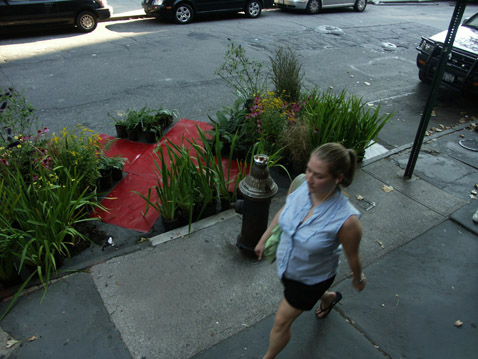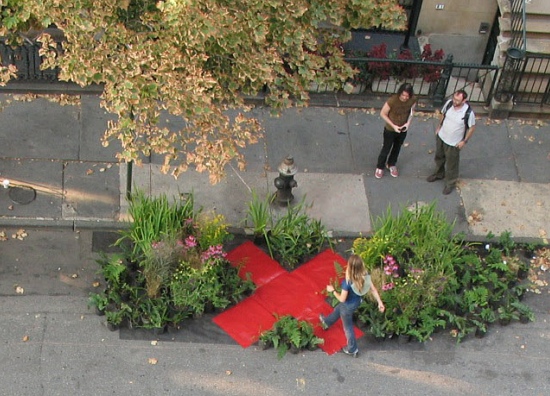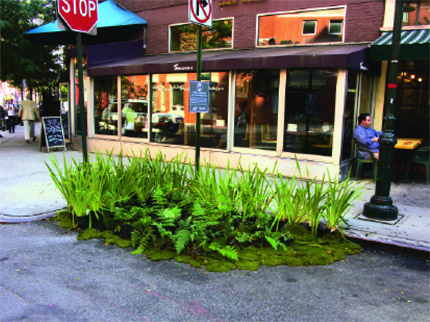Having only recently been introduced to Natalie Jeremijenko by way of a new facebook friend, I am excited to share one of many interesting and exciting ideas by this Artist/ Engineer/ Scientist. I am sure as I spend time deeply delving into her work, I will find myself sharing more of her great ideas. The first is basically a rain garden for cities. Urban landscape design constantly has to deal with runoff and it’s impacts and management but rarely uses the concepts of rain garden design to do it – and in particular – it is never done on a small-scale where people can enjoy the beauty of it.

Natalie and her colleagues have created a health clinic – like those that humans and animals might employ when we are sick – for the environment. With this view, they prescribe remedies for problems ailing our planet and our environment. On the ailments of degraded water quality and overflowing and polluted storm drainage, west Nile virus, pedestrian sidewalk slipping hazards, and excessive dog pee on sidewalks, they have prescribed NoParks.

No Park description from Natalie Jeremijenko’s Environmental Health Clinic Website:
NoPark returns “no parking zones” (mostly associated with fire hydrant placement) to low growth mosses and grasses. These micro engineered green spaces prevent storm water run off, use foliage to stabilize the soil, and to provide a durable low maintenance surface cover.
These microparks continue to provide emergency parking space for fire trucks (emergency vehicles can still drive over them as needed and they will re-generate). But the other 99.9% of the time they can do something more.
For all the same rationales that apply to green roofs, greening the no-standing zones is a good thing. Practically, noPARKS capture more water than green roofs (not being limited to carrying capacity of the 2″, 4″or 6″of soil that roofs require).
These no parking/standing zones are often situated where water collects, capturing the oily runoff from the road before it runs into the river. noPARKs recharge and replenish soil moisture on the block important to trees — even yards away — to help them dilute the gallons of uric acid poured on city trees plots each day by friendly neighborhood dogs.
Less water puddling decreases pedestrian slipping hazards. Lastly, the noPark reduces the number of standing water pools that are left for days, which are the perfect breeding ground for mosquitoes.
In this way, the noPark may reduce the need for widespread fumigation to combat West Nile virus in New York City.
In her TED presentation — fast forward to about minute 7 to the the bit about NoParks – Natalie describes how No Parks could mathematically eliminate all runoff pollution. (Aggregated, with 2-3 fire hydrants on every city block; if each were converted, the emergency parking system could infiltrate all the road-borne pollutants for up to a 7 inch rain event)
It is a remarkable idea, and I am not sure why we aren’t already doing this in every single city.

More about Natalie Jeremijenko:
Natalie Jeremijenko is an artist whose background includes studies in biochemistry, physics, neuroscience, and precision engineering. Jeremijenko’s projects, which explore socio-technical change, have been exhibited by several museums and galleries, including the MASSMoCA, the Whitney, and Smithsonian Cooper-Hewitt. A 1999 Rockefeller Fellow, she was recently named one of the 40 most influential designers by I.D. Magazine. Jeremijenko is the director of the environmental health clinic at NYU, assistant professor in Art, and affiliated with the Computer Science Dept.
Related Posts:
See Natalies cool ongoing exhibit at MassMOCA, in N Adams, MA
http://www.massmoca.org/event_details.php?id=296 live trees are inverted and suspended and growth is documented over time…